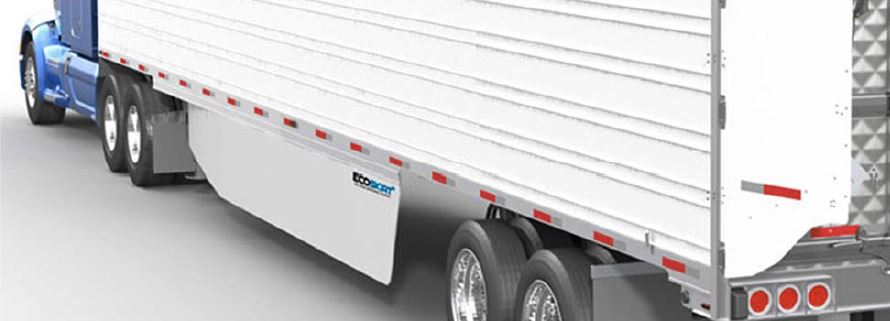Environmental, health groups lend support to trailer emissions standards
A group of environmental and public health groups are urging a federal appeals court to uphold trailer emissions regulations after the Truck Trailer Manufacturers Association argued trailers should be exempt.
On Tuesday, May 12, a coalition of environmental and health groups filed a brief as intervenor in the U.S. Court of Appeals in the District of Columbia in the case of the Truck Trailer Manufacturers Association versus the U.S. Environmental Protection Agency and the National Highway Traffic Safety Administration. TTMA argues that trailers should not be part of emissions standards. The coalition supports the EPA and NHTSA’s regulations.
At the center of the case is the definition of a “motor vehicle” under the regulations. TTMA argues that trailers are not motor vehicles. Therefore, emissions standards should not apply to trailers. However, EPA determined that tractor-trailers are motor vehicles because the combination is both “self-propelled” and “designed for transporting persons or property on a street or highway,” as defined by Congress.
In its brief, the coalition supports the government’s regulations as applied to trailers. Regarding self-propulsion, the coalition states that when a driver hits the gas, the entire tractor-trailer unit is propelled forward. Regarding the part designating the transport of person or property, the coalition points out that trailers are an essential part of the tractor-trailer, whose sole purpose is to serve as the cargo-hauling part of the vehicle.
Essentially, neither the tractor nor the trailer can fulfill the function of the vehicle without the other. Also, the tractor’s engine size is built to haul a loaded trailer.
TTMA argues that since trailers do not have engines they are not self-propelled. Therefore, trailers are not motor vehicles.
The coalition, along with the EPA and NHTSA, disagrees with that interpretation.
“Engines create propulsive power and produce emissions,” the coalition states in its brief. “By TTMA’s theory, tractors (i.e., the body, chassis, frame and wheels separate from the engine) would not be ‘self-propelled’ either, as they do not independently generate power or produce emissions any more than trailers do. TTMA assumes that tractors inherently include the engines (and the tires and frames) that allow for self-propulsion, but that tractor-trailers – which, unlike tractor cabs alone, are actually ‘designed for transporting … property’ – do not. There is no basis for this distinction.”

The coalition goes on to explain that attributes of both the tractor and trailer influence the emissions of an engine. Factors include weight of materials, aerodynamic design of the frame and resistance of tires. All those factors are “fundamentally the same” between trailer and tractor, according to the coalition.
“To say that a tractor somehow produces emissions while a trailer does not is to ignore the reality of how emissions are produced and muddle the (Clean Air) Act’s distinction between vehicles and vehicle engines,” the coalition argues.
In 2011, the EPA and NHTSA expressed their intent to set emissions standards for both tractors and trailers.
Initially, trailer standards were delayed, issuing standards only for the tractor cab. After several years of research the agencies finalized standards for model year 2018 and newer heavy-duty vehicles, including trailers.
Regulations apply to four types of trailers: box trailers, tank trailers, flatbed trailers and container chassis. Compliance phases in over a period of nine years with certain flexibilities. The standards do not dictate exactly what manufacturers have to do to comply. As long as trailers hit a set target regarding grams of CO2 per ton-mile, they are legal.
According to the court brief, those standards are premised on the use of bolt-on technologies that do not entail any redesign of a trailer. The accessories pay for themselves in fuel savings in just two years, the coalition claims. EPA estimates the cost per vehicle ranges from $850 to $1,110, or 3-4% of the cost of a typical trailer. Addressing the claim by TTMA of needing multiple technologies, the coalition claims using new tire technology alone will achieve compliance.
Led by the Environmental Defense Fund, other coalition members include the California Air Resources Board, Center for Biological Diversity, Natural Resources Defense Council, Sierra Club, Union of Concerned Scientists and the states of Connecticut, Iowa, Massachusetts, Oregon, Rhode Island, Vermont and Washington.
“The trailer makers’ arguments are so extreme not even the Trump EPA supports it,” Pete Huffman, a lawyer at Natural Resources Defense Council, said in a statement. “We intervened in this case in support of EPA to ensure trailer makers do their part to clean up their products. Making tractor-trailers more aerodynamic, with smoother-rolling tires, slashes 18-wheeler carbon emissions while paying for itself in fuel savings.”









